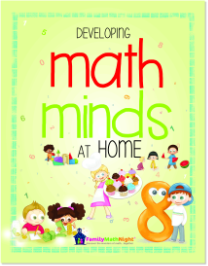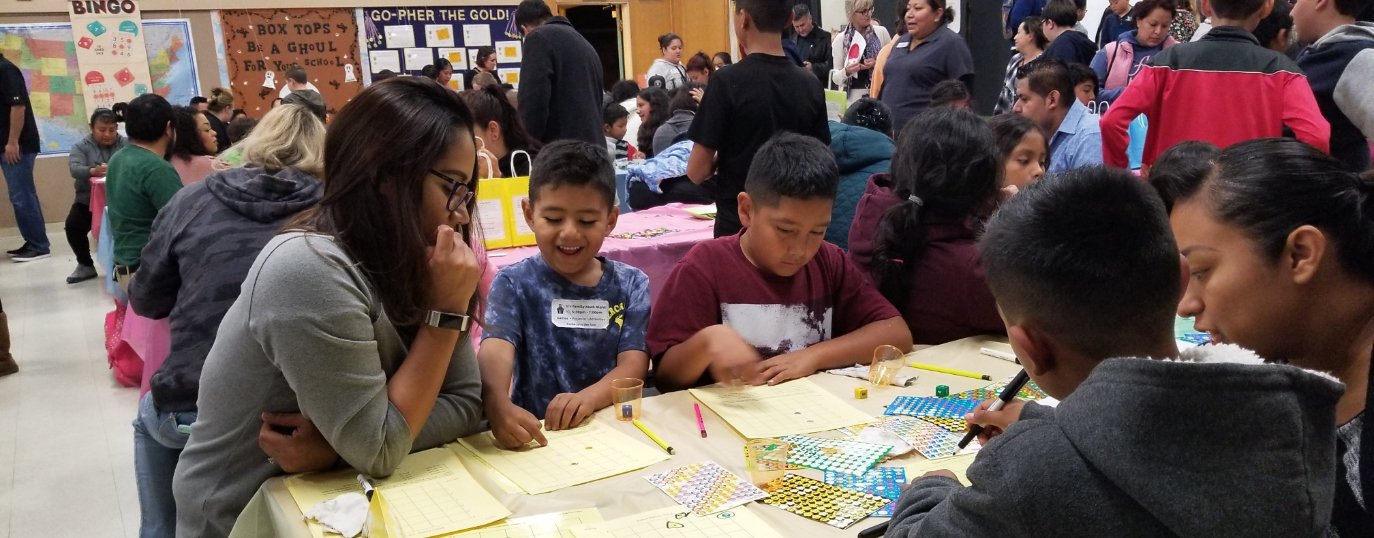Overview
Building strong family-school partnerships is key to developing academic achievement for all children. One way
to build these partnerships is through Family Math Night events. A Family Math Night event is hosted by
a school or organization allowing families to return to school in the evening and participate in hands-on math
activities. Hosting a Family Math Night can help engage parents meaningfully, reinforce positive math mindsets,
build a sense of community, and contribute to student academic success.
Use the Family Math Night Event Planning Guide below to help organize a K-5 Family Math Night event using the FREE
resources on our site.
STEP 1 Set the Date, Time, and Location
-
Date Be sure to check the master calendar to make sure that the date you
choose does not conflict with other
events.
-
Time Depending on how many stations you plan on having, 60 - 90 minutes is plenty of time for families to engage in hands-on math activities together.
-
Location School multi-purpose rooms are ideal for Family Math Nights as
having everyone in the same room helps build a sense of community.
STEP 2 Plan the Stations
After hosting Family Math Night events for over 20 years, we have found that including projects, games, and
activities offers a little something for everyone.

Did you know? All of our main
Event Kits include 24 different games, activities, and projects.
Activities
- Estimation
StationA hugely popular activity at events is the Estimation Station. Done correctly, it's
a powerful math activity for developing number sense. Check out these 5 tips that can help kids (and parents!)
think critically and flexibly about numbers.
- Math Scavenger
Hunt
Another super fun activity is our Math Scavenger Hunt. One idea is to hand families a scavenger hunt sheet and pencil as they sign in. During the event kids can hunt for math items to cross off their sheet. When
students find five-in-a-row they get to take a trip to the prize table.
- Sign-in Sheets
And speaking of signing in...why not make that fun, too! We are always looking for ways to tie in math into
everything and this is a perfect opportunity. Follow the link and check out the different ideas for “sign-in” sheets
we've done over the
years.
- What
Do You Notice?
Another great activity that really gets parents talking math with their kids is the What Do You Notice?
Station. This station includes a "poster” where kids share their mathematical thoughts on what they see
in the
poster. It's a pretty open-ended activity so no matter what age a student is, there will always be something
to notice. We have quite a variety for you to choose from.
- ABC's and 123's and How Much is Today Worth?
Both of these simple activities can be done on a variety of levels. You'll want to provide plastic coins for
How Much is Today Worth? so the younger students can physically manipulate the coins.
- Selfie Station
Finally, a super fun and whimsical activity is the Selfie Station. Although not really math, it's still fun to
watch families have fun being goofy together. And it's great for building a positive school climate.
Math Games
Playing games is a great way to reinforce what students are learning in the classroom in a way that's fun and
engaging. Plus it's a great opportunity to show parents how to use the tools students are using at school (ten
frames, number lines, etc).
Here are two dice games that we included in our Math-at-Home resource that was put together during the pandemic.
These games come from our Power Pack series. Each game has several versions to
choose from which is
great
for differentiation. To access these games, visit our Family Math at
Home resource and then click the Dice
Games link under the video to access the PDFs.
- Tens are Terrific (K/1)Optional support tools: ten frames
- In Between (2/3 and 4/5)The number cubes can be replaced by regular dot
dice.

Did you know? Our
Take-Home kits are filled with fun dice,
card, and
board games that help reinforce important number skills.
Projects
If there's glue and scissors at a station you can be sure it's going to be a hit! We always include a station
that ties math and art together. We have a lot of super fun crafty projects for you to choose from and
although
the lessons cost $2.50, our website will always include a FREE project for you to use.
STEP 3 Recruit Volunteers
Once you know how many stations you're going to offer, you're going to need volunteers to facilitate them.
Teachers and/or parents make great station facilitators. Upper grade students also make great station facilitators. It's a great leadership opportunity for them and they always step up and do a fabulous job. For more
information, check out our students as facilitators
blog post.
In addition to station facilitators, you may want to recruit volunteers to help run copies, set up the event,
take event photos, etc.
STEP 4 Promote, Promote, Promote
Now it's time to get the word out.
- Marquees, newsletters, social media
- Contact local media (they love a good community interest story)
- Invite district personnel
- Family Math Night Ambassadors - Send students
into the
classrooms to promote the event.
- Reminder stickers - Reminder Stickers are a great
way to get the word out. Follow the link to find ones to customize and print out.
(We include Reminder Stickers in our event kits).
- Link your event with a bake sale, ice-cream social or book fair
- Posters - Enlist the help of the Student Council to make posters to hang around the school
- Raffle - Who doesn't like the chance to win a prize?
- Homework pass or extra credit slip - always popular with students.
(We also include these in our event kits.)
- Additional ideas to promote your event
STEP 5 Event Day Room Set-Up
Organize the tables and chairs/benches into your stations keeping in mind the flow of participants.
Because first impressions are so important, we like to cover our tables with colorful plastic coverings to
give
the room a festive feel. Check out our room setup resource to see
examples of different ways you can set up your environment.
You'll also want to consider which stations need garbage/recycling bins.
It's also nice to set up a welcome table right when participants enter the room. As mentioned in STEP 2, we like
to include fun ways for families
to “sign-in”.

Did you know? Our
event kits include a variety of sign-in sheets for those schools needing to
document parent participation.
If you'll be offering food, it's nice to have an area set up just for families to eat. That way food stays at
those tables and the math stations remain food-free. If you don't have enough tables for both the food and math
stations, consider having just a few tables designated for eating and families eat during the event as space at
one of the tables becomes available.
STEP 6 Opening Doors
Greeters: It's nice for families to be greeted as they enter. This helps families feel welcomed. Greeters can
be the Family Math Night Coordinator, the Principal, or even students.
We like events to be structured as go-at-your-own-pace for families. This helps create a non-threatening environment as,
unfortunately, too many parents still feel uncomfortable with math.
Towards the end of the event, you may want to place evaluation forms on the sign-in table for families to take as they
leave.

Did you know? Our
event kits include both physical copies of evaluation forms that can be printed
and a table tent/poster
with
a QR code parents can scan on their way out.
You may also want to send home information about your math program or handouts on how they can help their
child at home with math. We have a variety of handouts for you to choose from in our Hosting a Family Math Night
event - Parent Handouts.

Did you know? We offer a
parent guide filled with simple yet powerful ways parents and caregivers can help strengthen their child's math skills and build a positive attitude towards math.
STEP 7 Post Event
Once the event is finished, it's important to follow-up with families.
- Send thank-you notes to adult volunteers and/or any special guests (district personnel, etc.)
- Highlight the event on social media, school website, newsletter, etc.
-
If you do one of the collaborative projects mentioned
in STEP 2, hang or place the project in the front
office. This can generate excitement for those who didn't attend to make sure they come to the next Family
Math
Night event.
- Pat yourself on the back for a job well done!






